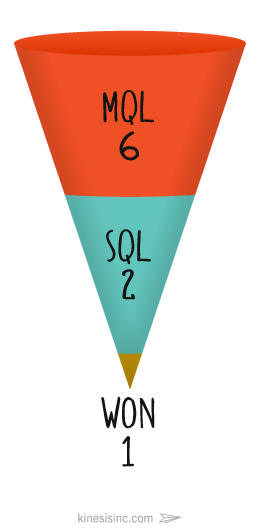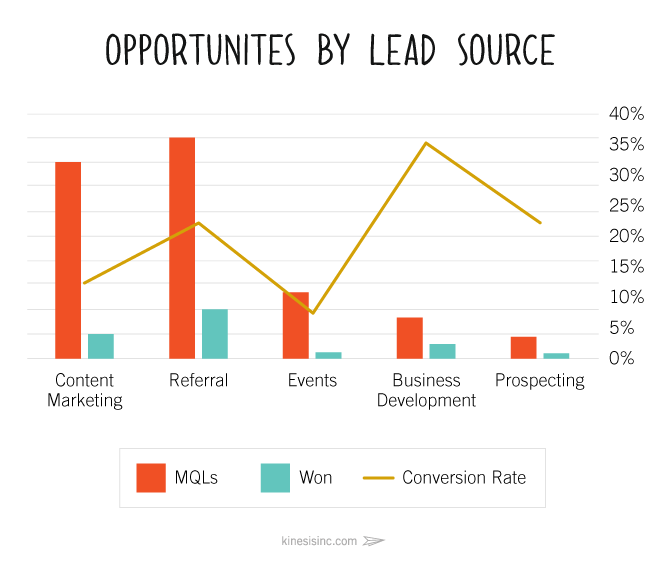
The Sell-Do Trap and How to Escape It
The “Sell-Do” trap describes businesses where the owners are responsible for both selling and delivering the work (they “sell” the work, then “do” the work).

Last month, around 20,000 people viewed the Kinesis website – a 15% increase from the same period in 2016. If you received our last email and opened it, you were one of about 26% of our readers (6% if you clicked through). Last year our email list grew by approximately 500 people – an average of about 1.5 new subscribers a day.
As Kinesis’ Marketing Manager, I like these numbers. In fact, writing that paragraph made me feel all warm and fuzzy inside. But here’s the dirty little secret about these figures, pretty as they may be:
They don’t matter.
Any good business leader knows that tracking KPIs is important. As the late great Peter Drucker put it, “You can’t manage what you don’t measure” – and the only way to achieve your goals is to monitor progress toward them. But what are those goals, and how can you be sure you’re tracking the right things to truly understand your performance?
I’ll admit, when it comes to marketing, it’s tempting to get wrapped up in all the glorious measurability of it. Advertising impressions! Twitter followers! Website traffic! (Oh my!) Not to mention likes, comments, shares, engagement rates, opens, clicks, subscribes, (unsubscribes,) pageviews, downloads, event registrations, and banana peel tripping frequency.
Okay, so I made that last one up – but the point is, marketing is awash with things to quantify and compare. But take heed: Marketing metrics are a flighty temptress.

They’ll whisper sweet nothings into your ear, like “Your Facebook post is performing better than 75% of posts on that page,” and you’ll stare dreamily off at the horizon believing your marketing efforts have been successful. The next morning, you’ll realize that you haven’t seen one extra dollar as a result of that Facebook performance… and when you go to question the metrics, said temptress will be nowhere to be found.
The fact is, marketing metrics are only valuable insofar as they move your business goals forward. If brand awareness is your only goal (a noble goal, to be sure), then by all means – pay close attention to session duration, user demographics, and social media engagement.
But if you’re like most of our clients, business goals can often be summed up in a single word: Growth. Which, let’s face it, can’t be measured in retweets.
Instead, at Kinesis we like to measure marketing success directly by the business it generates: How many sales opportunities are being created, and how qualified are those opportunities?
We’ve spoken at length before about the importance of implementing a sales CRM. By doing so, not only can you more effectively track leads and their progress through the sales pipeline, but you can begin to understand how that pipeline works and what to expect from it.
We’ll use Kinesis as an example. This is a statistical representation of our funnel, as reported by our CRM.

At Kinesis, we subscribe to the following definitions:
You can see that once a lead reaches the SQL stage at Kinesis, they have about a one in two (or 50%) chance of closing. Farther up the funnel, for every one deal we need to close, we should plan to bring in approximately six MQLs. If you were to zoom this out further, you’d know that it takes about 34 unqualified leads to convert to six MQLs. And so on.
What does this mean for our marketing department, you may ask? Well, we know from leadership how much additional revenue we need this year to meet our growth goals. From that, we can reasonably estimate how many new clients we would need to close. Simple enough, right?
That’s where the magic starts to happen.
Let’s say for instance that (as Kinesis’ Marketing Manager) I know that we need five more clients this quarter. Based on these conversion rates, I can confidently estimate that I need to generate no fewer than 30 phone calls with a salesperson.
Learning how to create those opportunities calls for a different report.

Here is another, different expression of our sales funnel – this time broken down by where each of our opportunities originated. For the sake of this example, I’ve consolidated many lead sources into a representative five.
You can see that like many B2B, professional service providers – our greatest source of leads is referrals (or word-of-mouth marketing). That means that if I want the most statistically probable route to new business, I should call upon our existing clients, partners, and brand advocates to share the Kinesis love. (That’s assuming, of course, that we’ve already built and nurtured our referral network.)
I might then turn to Content Marketing – and increase our activity on this blog, our Accelerator email series, and social media. In doing so, however, I would make note that our conversion rates here have been lower than the funnel-wide average (meaning I would need to generate 40, not 30, phone calls with a salesperson).
Then metrics like blog traffic and email clicks become more relevant… but only as long as they correlate to sales opportunities.
There are other factors to consider, here, of course – such as seasonality, what types of new clients we’re seeking out, and what bandwidth we have available to devote to these activities (for example, asking someone for a referral is a lot easier than, say, speaking at an event). But you get the gist.
By speaking the language of business and the sales funnel, we can:
And let me tell you, it beats the hell out of counting clicks.
So, if you’re looking to elevate your marketing strategy: Start the conversation with business goals, stoke your decision-making fire with data, and turn your marketing into an engine for growth.
The Kinesis Metrics Dashboard™ helps our clients track the health of their organization – including new customer acquisition and lead conversion. Learn more about our unique approach to marketing.
Get insights like this straight to your inbox.